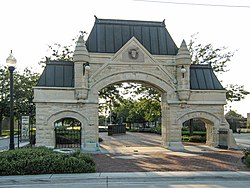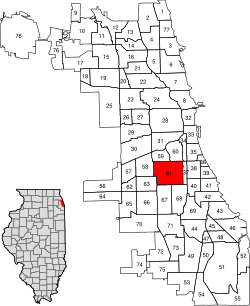New City, Chicago
New City
Back of the Yards/Canaryville | |
|---|---|
| Community Area 61—New City | |
 Union Stock Yard Gateat Exchange Ave. | |
 Location within the city of Chicago | |
| Coordinates:41°48.6′N87°39.6′W/ 41.8100°N 87.6600°W | |
| Country | United States |
| State | Illinois |
| County | Cook |
| City | Chicago |
| Neighborhoods | List
|
| Area | |
| • Total | 4.86 sq mi (12.59 km2) |
| Population (2020)[1] | |
| • Total | 43,628 |
| • Density | 9,000/sq mi (3,500/km2) |
| Demographics2020[1] | |
| •White | 12.4% |
| • Black | 23.1% |
| • Hispanic | 61.8% |
| • Asian | 1.9% |
| • Other | 0.8% |
| Time zone | UTC−6(CST) |
| • Summer (DST) | UTC−5(CDT) |
| ZIP Code | part of 60609 |
| Median income2020[1] | $35,396 |
| Source: U.S. Census, Record Information Services | |
New Cityis one of Chicago's 77official community areas,located on the southwest side of the city in theSouth Sidedistrict. It contains the neighborhoods of Canaryville and Back of the Yards.
The area was home to the famousUnion Stock Yardsuntil it closed in 1971, and theInternational Amphitheatreuntil it was demolished in 1999.
Neighborhoods[edit]
| Census | Pop. | Note | %± |
|---|---|---|---|
| 1930 | 87,103 | — | |
| 1940 | 80,725 | −7.3% | |
| 1950 | 75,917 | −6.0% | |
| 1960 | 67,428 | −11.2% | |
| 1970 | 60,747 | −9.9% | |
| 1980 | 55,860 | −8.0% | |
| 1990 | 53,226 | −4.7% | |
| 2000 | 51,721 | −2.8% | |
| 2010 | 44,377 | −14.2% | |
| 2020 | 43,628 | −1.7% | |
| [1][2] | |||
Back of the Yards[edit]
Back of the Yardsis an industrial and residential neighborhood so named because it was near the formerUnion Stock Yards,which employed thousands of European immigrants in the early 20th century. Life in this neighborhood was explored inUpton Sinclair's 1906 novelThe Jungle.The area was formerly part of the town ofLakeuntil it was annexed byChicagoin 1889. In the late 19th and early 20th centuries, the area was occupied largely by Eastern European immigrants and their descendants, who were predominantly ethnic Lithuanian,Bohemian,Moravian,andSlovak.[3]
In 1939, the activistSaul Alinskyand the local park directorJoseph Meeganorganized theBack of the Yards Neighborhood Council,where Alinsky first developed the method ofcommunity organizing.The prerequites of this successful attempt to bring together community leaders from different national Catholic churches, business, and labor were theGreat Depressionand the labor organizing work of thePackinghouse Workers Organizing Committee,a member of theCIOled in Chicago by Herb March. This work led to his founding theIndustrial Areas Foundationin 1940, which later trained community organizers.[4]
Jane Jacobs,in her 1961 bookThe Death and Life of Great American Cities,cites the Back of the Yards as an area able to "unslum" in the 1960s, due to a beneficial set of circumstances. This included a stabilized community base with skilled members who were willing to trade work to upgrade housing, as well as active and well-led local social and political organizations. Jacobs often cited the Back of the Yards as a model for other depressed neighborhoods to follow to upgrade their communities.[5]
Some time after the 1970s, when the stockyard operations closed and the number of nearby jobs decreased, many people left to move to newer housing and work in the suburbs. The population of the neighborhood gradually reflected a new wave of settlement, predominantlyMexican-American.
Canaryville[edit]
TheCanaryvilleneighborhood is one of the oldest neighborhoods in Chicago, and borders theBridgeportneighborhood. According to theEncyclopedia of Chicago,the neighborhood extends from Pershing Road to 49th Street and centers around Halsted Street. The area's residents experienced the development, and then decline, of themeat packingindustry, when Chicago was, in the words ofCarl Sandburg,"hog butcher for the world". Many of its residents found other work in thepost–World War IIyears.
Historically, Canaryville was a largelyIrish Americanneighborhood, starting Irish immigrants escaping theGreat Faminein the mid-19th century. They were deeply entrenched in the neighborhood, considering it their territory, and attempted to defend it against later arrivals of all races –including non-IrishWhite,Black,Hispanic,andAsianpeople. Its Irish gangs were active in attacks on Black people in theChicago Race Riot of 1919.Since the late 20th century, Latin American (predominantlyMexican) immigrants and their descendants have moved into the area.[6]Canaryville is now largely both Irish and Mexican.
Canaryville's name may refer to the sparrows who fed in the stockyards and railroad cars in the late 1800s. The name may also refer to white youth gangs in the neighborhood from the early 1900s, who were known as "wild canaries".[6]
Politics[edit]
The New City community area supported theDemocratic Partyin the2012and2016presidential elections. In 2016, New City cast 8,897 votes forHillary Clintonand 1,331 votes forDonald Trump(84.40% to 12.63%).[7]In 2012, New City cast 9,053 votes forBarack Obamaand 1,009 votes forMitt Romney(89.36% to 9.96%).[8]
In the 2020 election, Canaryville largely voted for Donald Trump in contrast to its surrounding neighborhoods, with Trump having 820 votes compared toJoe Biden's 673.[9]
References[edit]
- ^abcd"Community Data Snapshot - New City"(PDF).cmap.illinois.gov. MetroPulse.RetrievedJuly 11,2020.
- ^Paral, Rob."Chicago Community Areas Historical Data".Archived fromthe originalon March 18, 2013.RetrievedSeptember 3,2012.
- ^"Back of the Yards",Encyclopedia of Chicago
- ^Sanford D. Horwitt:Let Them Call Me Rebel: Saul Alinsky. His Life and Legacy.Vintage Books, New York 1992, pp. 56–87.
- ^Jacobs, Jane.The Death and Life of Great American Cities.New York: Random House, 1961.
- ^ab"Canaryville",Encyclopedia of Chicago
- ^Ali, Tanveer (November 9, 2016)."How Every Chicago Neighborhood Voted In The 2016 Presidential Election".DNAInfo.Archived fromthe originalon September 24, 2019.RetrievedOctober 4,2019.
- ^Ali, Tanveer (November 9, 2012)."How Every Chicago Neighborhood Voted In The 2012 Presidential Election".DNAInfo.Archived fromthe originalon February 3, 2019.RetrievedOctober 4,2019.
- ^Park, Alice; Smart, Charlie; Taylor, Rumsey; Watkins, Miles (February 2, 2021)."An Extremely Detailed Map of the 2020 Election".The New York Times.ISSN0362-4331.RetrievedJanuary 11,2024.
External links[edit]
- Official City of Chicago New City Community Map
- Back of the Yards Neighborhood Council(oldest community organization in the United States, founded by Alinsky in 1939)
